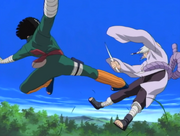mNo edit summary |
mNo edit summary |
||
| (47 intermediate revisions by 24 users not shown) | |||
| Line 1: | Line 1: | ||
{{Infobox/Jutsu |
{{Infobox/Jutsu |
||
| + | |top={{Looking for|the technique used by Rock Lee in episode 123|the technique used by Rock Lee in episode 22|Leaf Gale}} |
||
|ref=<ref>First Databook, page 184</ref> |
|ref=<ref>First Databook, page 184</ref> |
||
| + | |image=Leaf Whirlwind.png |
||
|kanji=木ノ葉旋風 |
|kanji=木ノ葉旋風 |
||
| + | |unnamed jutsu=No |
||
|romaji=Konoha Senpū |
|romaji=Konoha Senpū |
||
| − | |literal english=Leaf Whirlwind |
+ | |literal english=Tree Leaf Whirlwind |
|english tv=Leaf Hurricane |
|english tv=Leaf Hurricane |
||
|viz manga=Konoha Whirlwind |
|viz manga=Konoha Whirlwind |
||
| Line 10: | Line 13: | ||
|jutsu class type=Offensive |
|jutsu class type=Offensive |
||
|jutsu range=Short |
|jutsu range=Short |
||
| − | |users=Might Guy, Rock Lee |
+ | |users=Might Guy, Rock Lee, Chen~anime, Naruto Uzumaki~game |
|debut manga=37 |
|debut manga=37 |
||
|debut anime=22 |
|debut anime=22 |
||
|debut shippuden=No |
|debut shippuden=No |
||
| + | |novel debut=Kakashi Hiden: Lightning in the Icy Sky |
||
| ⚫ | |||
| + | |game debut=Naruto: Clash of Ninja |
||
| ⚫ | |||
}} |
}} |
||
| + | A taijutsu where one launches a succession of high kicks and low kicks. Firstly, the opponent's evasion margin is restrained upon seeing the high kick, thus augmenting the chances for the low kick to hit the mark. So originally the high kick is little more than a feint. |
||
| − | This technique involves a powerful leap forward followed by a spinning kick with both legs in succession, the second kick being aimed lower in case the intended target ducks the first. |
||
| − | == |
+ | == See Also == |
| + | * [[Takigakure Whirlwind]] |
||
| + | |||
| + | == References == |
||
<references/> |
<references/> |
||
| + | |||
| + | [[es:Remolino de la Hoja]] |
||
Revision as of 17:29, 18 April 2015
| This article is about the technique used by Rock Lee in episode 123. For the technique used by Rock Lee in episode 22, see Leaf Gale. |
A taijutsu where one launches a succession of high kicks and low kicks. Firstly, the opponent's evasion margin is restrained upon seeing the high kick, thus augmenting the chances for the low kick to hit the mark. So originally the high kick is little more than a feint.
See Also
References
- ↑ First Databook, page 184

